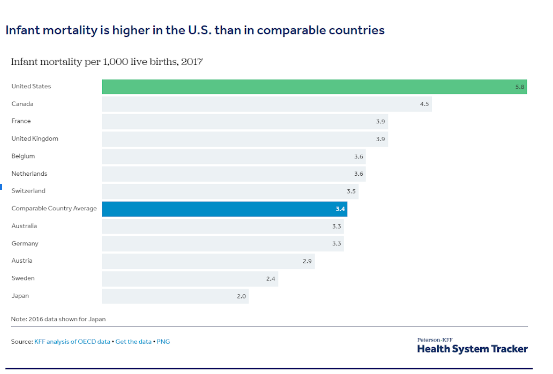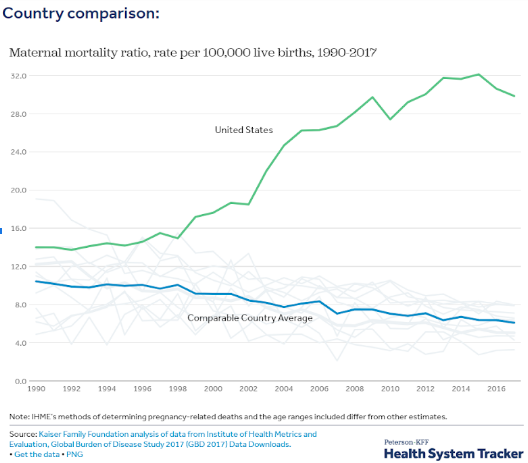Babies and mothers in the United States die at substantially higher rates than those in comparable countries like the United Kingdom and France. The U.S. has an infant mortality rate of 5.8 per 1,000 live births whereas the average comparable country has an infant mortality rate of just 3.4 per 1,000 live births.
Representatives Lauren Underwood (D-IL) and Alma Adams (D-NC) hosted a panel on Capitol Hill Tuesday on the subject of infant and maternal mortality, two metrics where the United States underperforms in contrast with comparable countries and where women and babies of color are far more likely to die than mothers and babies of other races due to pregnancy-related causes.
The disparity grows even wider when looking at maternal mortality rates. While most comparable countries have seen a steady decline in their maternal mortality rates, the rate at which mothers die due to pregnancy-related complications in the U.S. has increased. The U.S. maternal mortality rate was 29.9 per 100,000 live births in contrast with just 6.1 per 100,000 in the average comparable country.


In addition, the statistics on maternal mortality are only one part of the story. For every mother that dies during childbirth, there are about 70 mothers who nearly die due to severe health complications like hemorrhages and organ failure.
“We’re still facing a public health crisis with moms in America today more likely to die in childbirth than mothers in any other developed nation,” Adams said. “When you start to drill down into that shocking fact, one thing becomes clear: the majority of the women dying are African American.”
According to the Center for Disease Control, black and indigenous women die from pregnancy-related causes at three times the rate of white women. That disparity persists through infant mortality rates as well, with infant mortality for black babies at 11.4 per 1,000 live births and for white babies 4.9 per 1,000.
One panelist, Rachel Hardeman, an Assistant Professor of Health Policy and Management at the University of Minnesota, linked the racial disparity in infant and maternal mortality to the 400 years-long history of slavery and racial oppression in the U.S.
“These actions were built on a foundation of white supremacy that persists today,” Hardeman said. “60 percent of our country’s history is built on black enslavement and about 22 percent on Jim Crow.”
In April, Representatives Underwood and Adams launched the Black Maternal Health Caucus with the goal of establishing black maternal health as a national priority. According to Underwood, the caucus has grown in size since April and now has more than 90 members including both Democrats and Republicans.
“For Congresswoman Adams and I the motivation to launch the caucus stemmed from alarming data and personal experiences,” Underwood said. “The numbers alone are staggering but behind each statistic is a story. Congresswoman Adams has seen the unique risks facing black mothers and so have I.”
Underwood touted two pieces of legislation which both passed out of the House Energy and Commerce Committee on Tuesday as examples of the accomplishments of the Black Maternal Health Caucus. the Maternal Health Quality Improvement Act and the Helping MOMS Act.
The Maternal Health Improvement Act would offer grants for to “eligible entities” that provide maternal health care services in rural and medically underserved areas as well as tribal organizations for Native Americans. The bill would also require grant recipients to implement new training programs for healthcare providers with a focus on maternal care and implicit bias.
The Helping MOMS Act would incentivize states to extend Medicaid coverage to new mothers for a full year postpartum.

